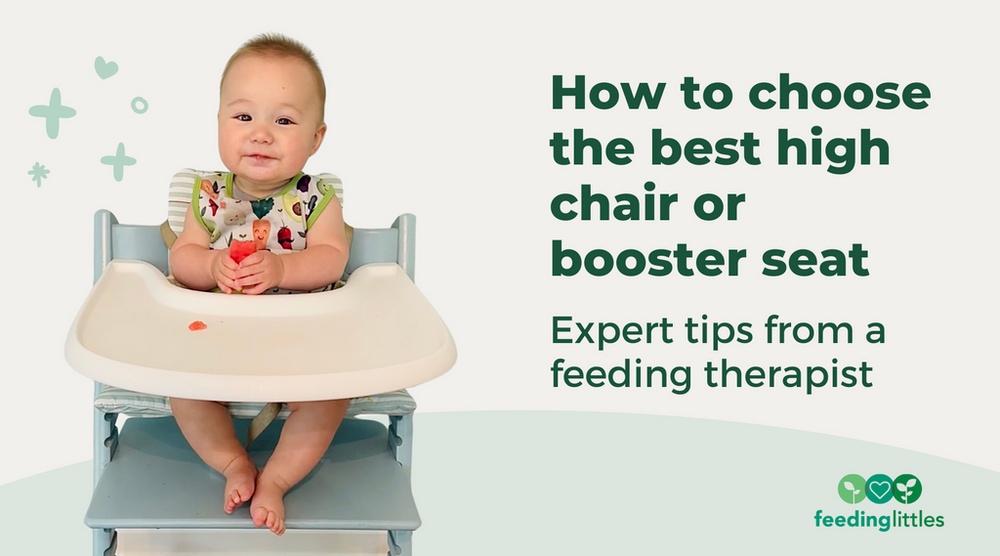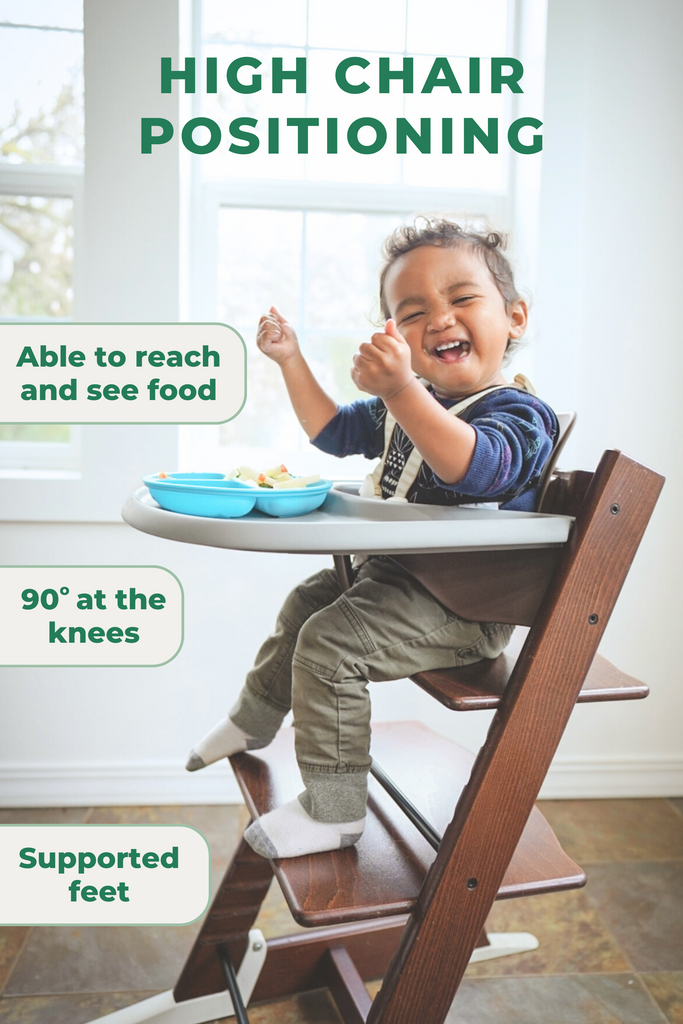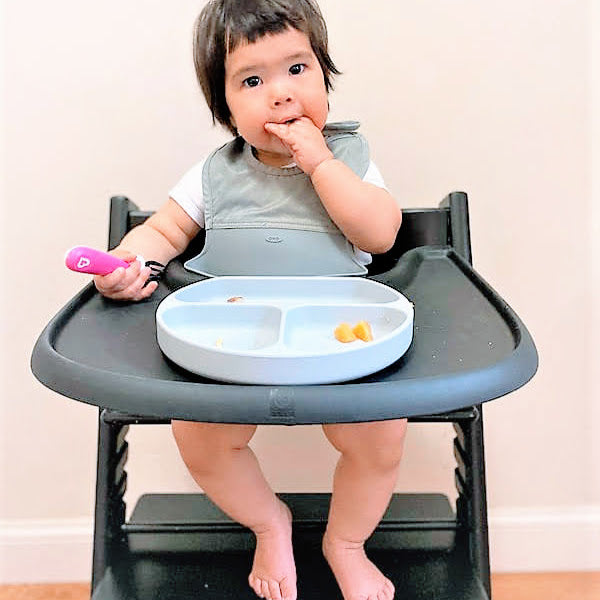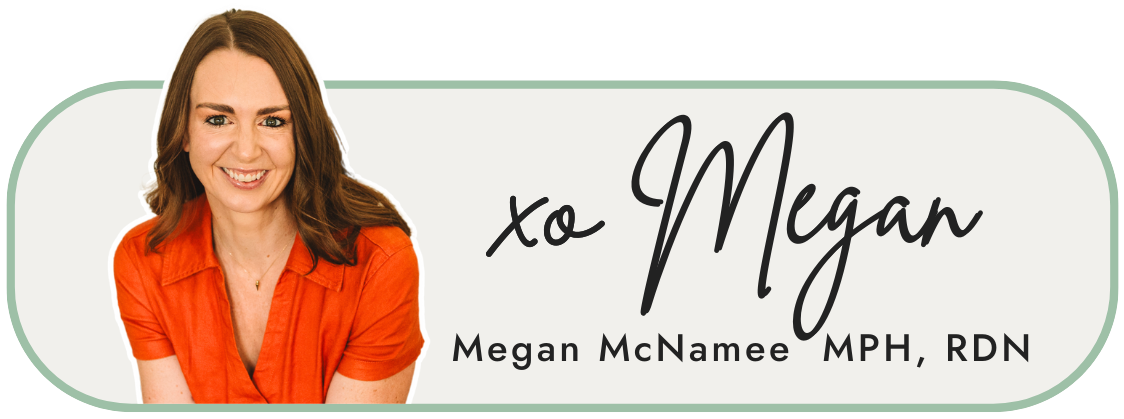
Selecting baby gear is one of the more overwhelming parts of parenthood. There are so many options available, and friends, family members, online groups and Amazon reviews all pull you in different directions. How do you know what’s best? Let's start with what feeding therapists look for in high chairs so you can make the best decision for your family.
Main points:
- We want babies and toddlers to be well-supported in their high chair so they are comfortable enough to sit and eat. When babies feet dangle, they're leaning back, or they can't see or reach their food well, they're less likely to stay seated for a meal.
- Choose a high chair that promotes proper positioning - see our favorites below. We especially like high chairs that can be pushed up to the table once the tray is removed so your child is seated similarly to you as they eat.
- Good positioning in a high chair can make a really big difference. In practice, we've seen monumental changes in how children eat when we put them in a chair that promotes good posture and stability. You can likely modify your chair to make it more comfortable for your child.
Our favorite high chairs:
Read on for why we love these products.
Disclosure: some links below are affiliate links, which means (at no cost to you) we will make a small commission if you click through and make a purchase via Amazon. Check out our entire Amazon store here. We do not receive sponsorships by companies to promote specific products.

What is good positioning, and why does it matter?
As a feeding specialist, co-founder Judy Delaware OTR/L, CLC has a few favorite high chairs, but almost every high chair can be modified to help your baby or toddler be most successful at mealtime. You see, when humans are well-positioned for any activity, we are more likely to stay and endure that activity longer. We really want our babies and toddlers to want to sit in their high chair and participate in eating, not get out right away because they’re uncomfortable or unstable.
Think about it like this – when you go to a bar at a restaurant, there’s always a place to put your feet. Restaurants know that patrons will sit longer when they’re comfortable. The same concept holds true for your baby, toddler or big kid.
Most high chairs are created to be easy to clean or transport, but they don’t actually promote great postural dynamics. They may support a baby that doesn’t have good independent sitting skills, but they don’t lead to successful positioning long-term.
(Note: before babies start eating any food, they should be sitting with minimal assistance on the floor first, not just propped in a high chair barring any medical or developmental issues. Read more here.)
Many of our Infant and Toddler & Kid Course clients have changed their child’s high chair positioning and have noticed monumental improvement in eating – it really does matter!
How should my child look while seated in their high chair?
- Look for 90 degrees at the hips, knees and ankles.
- Make sure their feet can reach a foot rest.
- Ensure they're able to lean forward and reach food.
A little more info about positioning:
- We want kids positioned just like an adult would be in a chair. Look for 90 degrees at the hips, knees and ankles and a support under the feet.
- Make sure your child does not lean to either side. If they do, consider adding a rolled up pillow or towel. Remember, your baby should be sitting independently on the floor before you start food, but we don’t expect them to have long sitting endurance in this positioning. Some additional support may help them feel comfortable and not lean to one side.
- If your high chair is too big for your baby, add a small towel roll behind their back for added support and stability. This is similar to adding a pillow behind your back if you can’t reach the back rest on a chair.
- Ensure that your high chair or booster has a foot rest that reaches their feet. Most of the chairs we recommend below have an adjustable foot rest that reach many 6 month old’s feet. If you need to modify the foot rest, use a tissue box, zip-lock bag box or pool noodle and adhere it to the chair using fun duct tape or double-sided Velcro.
- Make certain that the tray of the high chair/booster is at the right height of your baby to reach the food (chest height or below). If your baby isn’t tall enough or doesn’t have long enough arms, consider adding a small towel beneath your baby to allow them to reach food on their tray or the table even better.
- Make sure your baby can lean forward in their chair to reach their food. This is called a positive tilt, and it's what adults do at the table too!
- Many high chairs/boosters come with a recline feature. This is NOT a necessary feature, as we never want children to eat solids (including purees) in a reclined position.
What other logistical and safety factors are important in selecting a high chair?
- Inspect the safety harness of your chair. Look for its ability to be cleaned, and if you are obtaining a gently used high chair/booster, be sure that the straps are intact.
- If you decide not to use the straps, make sure that your baby cannot get out of the high chair.
- Consider a chair that is easy to wipe down and clean. Food tends to get stuck in small crevices.
- Before purchasing a new high chair/booster, measure the height of your kitchen table, as some high chairs are pretty short.
- Bring the high chair/booster to the table and get your baby as close to the table as possible from the beginning. We want your child to feel part of the meal experience – not eating off in a corner. If you eat at a counter height table, consider a high chair that clips onto the side of a table like the Phil and Ted’s Lobster. (If you use a clip-on chair, consider adding a foot rest by sliding a box or stool under baby’s feet.)
- Does the high chair/booster have a removable and tray? This is a great feature because as your baby gets older you can slide her chair directly up to the table. This also eliminates the need to convert to a booster. Our favorite chairs that do this are the Stokke Tripp Trapp, the Keekaroo Height Right, the Abiie Beyond, the Mockingbird High Chair or the Stokke Steps.

What are our favorite high chairs?
As mentioned above, most chairs can be modified for good positioning, but we wanted to share our Feeding Littles-approved chairs so you know that the chair you buy promotes good posture. When evaluating our favorite chairs, I considered positioning, ease of cleaning, adjustability, and general ergonomics.
The following chairs are our absolute favorite high chairs because the foot rest can be brought up to reach most 6 month old’s feet, and the baby can easily lean forward in the (ideal) positive tilt position to reach food. These chairs are also super easy to clean, slide up to the table to avoid needing a booster, and come in multiple colors (bonus)!
Top Picks:
Other favorites
The chairs listed below promote generally good sitting dynamics but may need to be modified with a foot rest until baby’s legs are long enough.
- Chico Polly
- Graco Blossom 6-in-1
- Phil and Ted’s Lobster – clip-on if you have a counter height table or can’t use a regular high chair – modify with a foot rest
- Inglesina Table Chair – also clips on
A word about the IKEA high chair…
Many families love the IKEA ANTILOP high chair because it’s inexpensive (around $23) and easy to clean. However, the seat on this chair is deep so baby is far away from the edge of the tray when their back is supported, and the tray is difficult to maneuver and remove. It’s just too big for many babies if not modified. If you decide to use this chair we recommend adding rolled up towels around your baby (or using one of the support pillows IKEA sells) and using one of the hacks shown below to add a footrest.
Some companies have created ANTILOP accessories that help add stability and comfort to this chair. Check out Yeah Baby Goods for ANTILOP cushions, placemats and footrests.
IKEA recently released the LANGUR high chair, which is a more ideal option because it has a foot rest (although it may not reach baby’s feet), a better back rest, and a more user-friendly tray.
My child can't reach their footrest - how can I modify it?
- Tie or slide an elastic exercise band around the legs to make a makeshift footrest.
- Tape a saran wrap box to the high chair to create a makeshift footrest.
- If possible, slide a dining chair behind the high chair so the seat creates a footrest. (This sometimes works with the IKEA Antilop chair!)
What about booster seats?
Booster chairs are meant to transition a toddler from a regular high chair to sitting at the right height with their family at the table. Ideally we want food no higher than your child’s chest, so a booster allows a young eater to see their food when in a regular chair. Again, if you use some of the preferred chairs above, you probably don’t need to purchase a booster seat, since these chairs slide right up to the table with the tray removed.
When is your child ready for a booster chair? Many toddlers get antsy in a high chair with a tray sometime around 18-24 months, but it may happen earlier or later. We recommend keeping your child in their chair as long as they are comfortable and are willing to sit in their high chair, but eventually most kids want to sit with you at the table. If they're doing well in their high chair, let them stay in it - there's no rush to switch to a booster!
If I have one of the chairs you recommend that slides right up to the table, when should I take off the tray? This is up to you! We want your baby close to the table in their high chair, and sliding them right to the table with the tray removed is a great way for them to be an active part of the meal. It’s important that your child is stable in their seat before removing the tray, as the tray helps keep them secure in the seat. Experiment with taking off the tray as your child enters toddlerhood, especially if they don’t like being contained by the tray any longer.
What about a foot rest when I’m using a booster seat? Your child might not have supported feet in a typical booster seat. The high chairs we recommend above can be converted to chairs you slide up to the table that still allow for a foot rest. They may be a better investment long-term because you don’t need to buy a separate booster seat. If you have a traditional booster seat, you might be able to add a box under their feet to give them a footrest.
- Fisher Price Space Saver
- Ingenuity 2 in 1
- OXO Tot Nest
- Ingenuity Toddler Booster
- Dreambaby Grab ‘N Go
- Inglesina Fast Table Chair – clips onto table
- Phil and Ted’s Lobster - clips onto chair
What about propped sitting chairs or floor seats like the Bumbo?
The Bumbo floor seat (with the round leg holes) and propped sitting chairs don’t teach a baby to sit and put their hips in an unfavorable posterior tilt position. We recommend avoiding these chairs or using them sparingly, and we don’t recommend them for feeding.
We hope this helped you know how to best position your baby or child in their high chair or booster!
